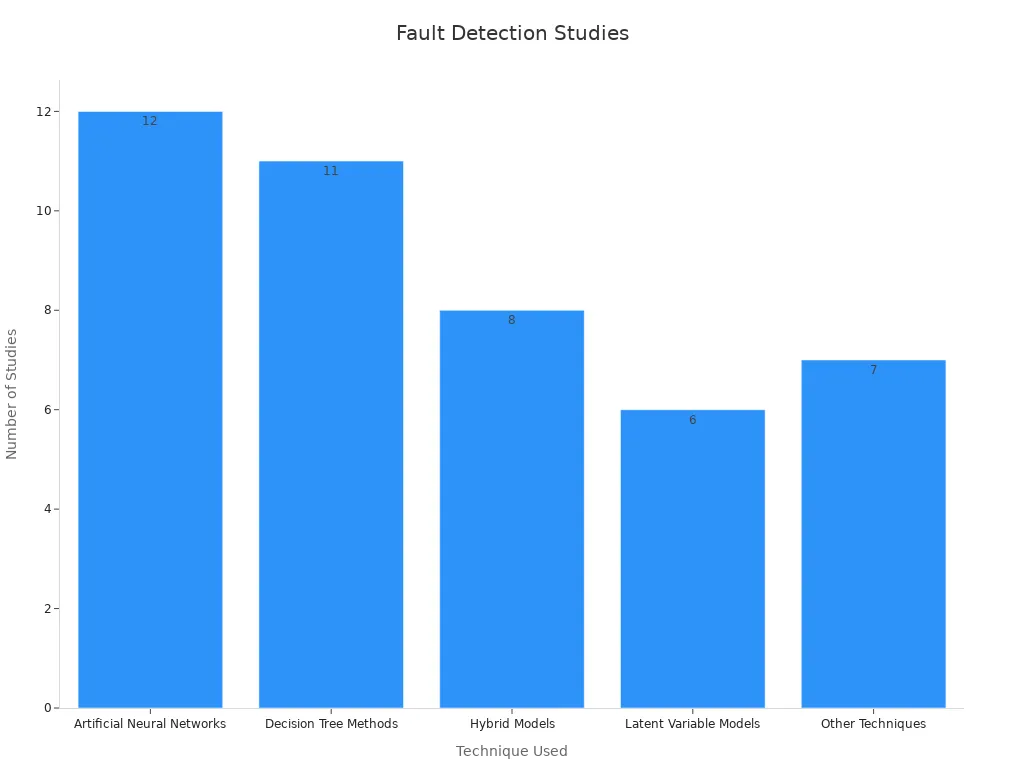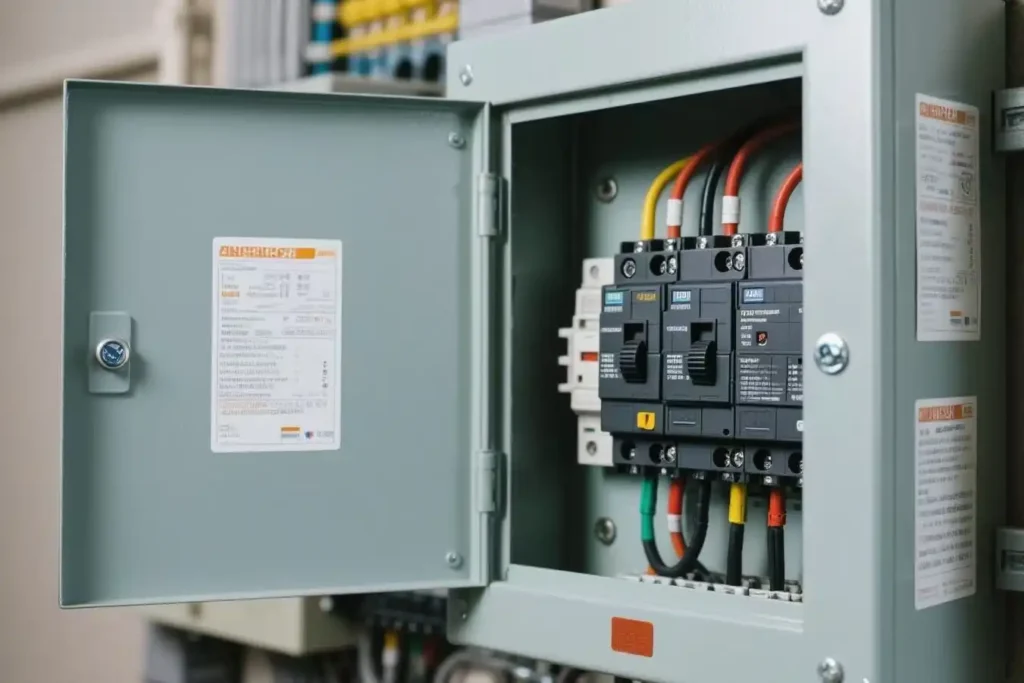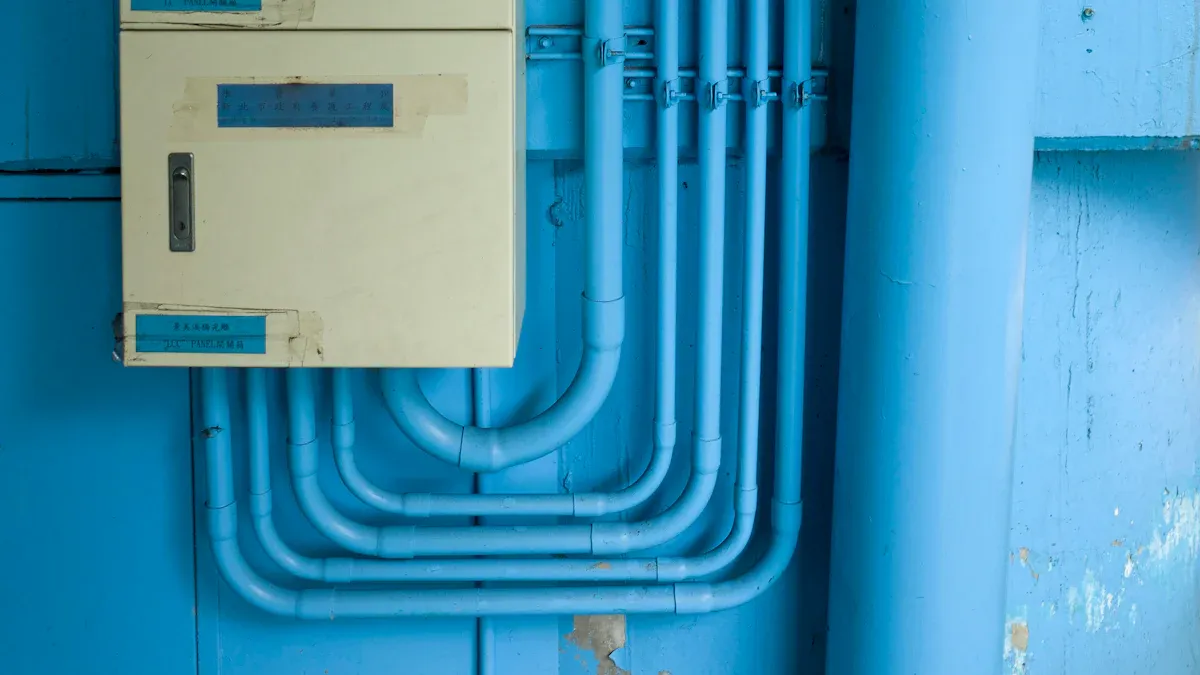The distribution box plays a crucial function in the distribution box of electrical systems. It helps electricity move safely to different circuits, ensuring that power is utilized efficiently. This box protects your home from electrical dangers and facilitates easy control and monitoring of your system. In residential settings, it is equipped with safety tools like circuit breakers and insulation, which safeguard your appliances and wires from harm. Overall, the function of the distribution box is key to maintaining the safety and efficiency of your electrical system.
Key Takeaways
-
A distribution box helps send electricity safely to different circuits at home.
-
The circuit breakers inside stop overloads and short circuits, keeping devices safe.
-
Checking and fixing the box often can stop big problems and save money.
-
Picking a box with extra room lets you add more later and avoids overloading.
-
Grounding and insulation are important to stop shocks and keep the system working well.
Power Distribution in a Distribution Box
How the Distribution Box Allocates Electricity to Circuits
The distribution box is the main control center for electricity. It links the power from the utility company to your home circuits. Inside, tools like circuit breakers or fuses keep electricity flowing safely. These tools stop the current if it gets too high, avoiding overloads or short circuits.
Each circuit in the distribution box has a specific job. For instance, one circuit might run your kitchen appliances, while another powers your lights. This setup lets you turn off or fix one circuit without affecting others. By dividing electricity this way, the distribution box keeps your system safe and working well.
Tip: Pick a distribution box with enough space for future power needs. This prevents overloading and makes upgrades easier.
Importance of Organized Power Flow in Electrical Systems
Organized power flow keeps your electrical system safe and efficient. A good distribution box sends electricity to the right circuits without problems. This avoids voltage drops that can harm devices or shorten their life.
It also makes fixing issues easier. If a circuit breaks, you can find and fix it quickly without disturbing other circuits. This saves time and prevents more damage. Plus, efficient power use lowers energy waste, cutting costs and helping the environment.
To learn more about power flow, experts have done many studies. The table below shows some important research:
|
Title |
Source |
|---|---|
|
Power flow analysis using quantum and digital annealers: a discrete combinatorial optimization approach |
|
|
CDFLOW: A practical tool for tracing stationary behaviors of general distribution networks |
Sheng, H. & Chiang, H.-D. IEEE Trans. Power Syst. 29, 1365–1371. https://doi.org/10.1109/TPWRS.2013.2289917 (2014) |
|
Load-flow solutions for Ill-conditioned power systems by a Newton-like method |
Tripathy, S., Prasad, G., Malik, O. & Hope, G. IEEE Trans. Power Appar. Syst. PAS–101, 3648–3657. https://doi.org/10.1109/TPAS.1982.317050 (1982) |
|
Mann-iteration process for power flow calculation of large-scale Ill-conditioned systems: Theoretical analysis and numerical results |
Tostado-Veliz, M. et al. IEEE Access 9, 132255–132266. https://doi.org/10.1109/ACCESS.2021.3114969 (2021) |
|
A dynamized power flow method based on differential transformation |
Liu, Y., Sun, K. & Dong, J. IEEE Access 8, 182441–182450. https://doi.org/10.1109/ACCESS.2020.3028060 (2020) |
|
Time Series Power Flow Analysis for Distribution Connected PV Generation |
By keeping power flow organized, the distribution box protects circuits and improves power reliability.
Safety Features of an Electrical Distribution Box
How Circuit Breakers Stop Overloads and Short Circuits
Circuit breakers are key parts of a distribution box. They work like switches that turn off electricity during unsafe conditions. This keeps your circuits safe and protects your home devices.
Circuit breakers stop problems in many ways. They prevent too much electricity from flowing by watching the current. If the current gets too high, they shut off to stop overheating. They also stop short circuits. When a short circuit happens, the breaker quickly cuts the power to avoid fires or damage. Newer models also protect against ground faults and arc faults, which can cause shocks or fires.
Modern circuit breakers have extra features. Some include Ground Fault Circuit Interrupters (GFCI) and Arc Fault Circuit Interrupters (AFCI). These features lower fire risks and protect people from shocks. Some breakers even track energy use, helping you save power and money. Upgrading to these breakers makes your system safer and more reliable.
Note: Molded case circuit breakers (MCCBs) are common in homes and businesses. They are dependable and come in different types for various needs.
Why Grounding and Insulation Are Important
Grounding and insulation are crucial for a safe distribution box. Grounding sends extra electricity safely into the ground. This stops shocks and protects people and devices. Without grounding, electrical problems could cause fires or injuries.
Insulation keeps electrical parts separate from each other. It stops electricity from leaking and prevents short circuits. Strong insulation materials inside the box protect wires from heat or moisture. This keeps your system working well and your devices safe.
Together, grounding and insulation make the system safer. They reduce risks from overloading and electrical problems. Regular checks can find issues with grounding or insulation. Fixing these problems keeps your system safe and up to date.
Control and Management in a Distribution Box
Centralized Monitoring of Electrical Systems
A distribution box helps you monitor your electrical system easily. It lets you see the status of circuits instantly. You can check if a circuit is working, overloaded, or has issues. This control keeps your power steady and reliable.
Monitoring improves how your system works. You can spot problems early and fix them quickly. For example:
-
Checking equipment in real time helps you avoid big issues.
-
Predicting maintenance needs stops sudden failures, saving time and money.
-
Viewing data clearly helps you understand system performance faster.
Using a distribution box with monitoring gives you better control. It boosts safety and keeps your circuits running smoothly.
Simplifying Maintenance and Troubleshooting
A distribution box does more than distribute power; it helps with repairs. If a breaker trips, the box shows which circuit is affected. This saves time by avoiding a full system check.
Organized boxes make fixing problems quicker. Labeled circuits help you find and fix issues without stopping everything. Many modern boxes have tools to diagnose problems. These tools show current flow and faults, making repairs easier.
Choosing the right box prepares you for future upgrades. Boxes with extra space let you add circuits as needed. This keeps your system flexible and ready for growth.
Tip: Check your distribution box often to ensure all parts work well. Regular checks stop big problems and keep your power reliable.
Key Parts of a Distribution Box
Circuit Breakers: What They Do and Why They Matter
Circuit breakers are vital in a distribution box. They stop electricity flow during unsafe situations. If there’s an overload or short circuit, they cut the power. This prevents damage to wires and devices. Quick action lowers the chance of fires or other dangers.
How well a circuit breaker works depends on a few things. Its age, how often it stops faults, and its upkeep all matter. Studies show regular care and spare parts make them more reliable. Newer breakers have extra features like GFCI and AFCI. These protect against ground faults and arcs, adding more safety.
Tip: Pick circuit breakers that fit your power needs for better safety.
Busbars: How They Help Distribute Power
Busbars are key for spreading power in a distribution box. These metal strips, usually copper or aluminum, send electricity to circuits. They conduct electricity well and lose little energy, making them efficient.
Industries like busbars because they save energy. They are built to lower resistance, improving performance. Modern busbars are even better for today’s energy needs. Their small size makes them great for low-voltage systems where space matters.
Adding busbars to your distribution box ensures steady and efficient power flow. They are a must-have for modern electrical setups.
Switches and Fuses: Keeping Things Safe and Controlled
Switches let you turn circuits on or off by hand. Fuses break the connection if the current gets too high, protecting your system.
Rules like NEMA Standards KS 3 stress checking switches often. Fuses should be in ungrounded wires to protect equipment and cables. Together, these parts stop problems and keep your system safe.
Note: Check switches and fuses regularly to keep your system working well.
Enclosure: Protecting Internal Components
The enclosure of a distribution box keeps its parts safe. It works like a shield, protecting items like circuit breakers and switches. Without it, dust, water, or impacts could harm these parts. This might cause your electrical system to fail.
Modern enclosures are built to handle tough situations. Some stop shocks and vibrations, keeping parts steady. Others block outside electrical signals, avoiding interference. These features help your system stay reliable and prevent problems.
In risky places, special enclosures are needed. Explosion-proof ones stop flames and handle strong blasts. They are important in areas with flammable gases or dust. Picking the right enclosure keeps your system safe in harsh conditions.
The enclosure also protects wires and connections. This ensures power flows smoothly without interruptions. Reliable power is important for homes and businesses.
When choosing a distribution box, check the enclosure’s material and design. Strong materials like steel or plastic last longer and protect better. Regular checks can find damage early, keeping your system safe.
Tip: Pick an enclosure that fits your location’s environment. This gives better protection and makes your distribution box last longer.
Additional Features of a Distribution Box
Tools for Finding Electrical Problems
A distribution box with special tools can find problems fast. These tools check the system for issues like overloads or short circuits. Advanced methods, like neural networks and decision trees, make finding problems more accurate. They study how electricity flows to spot trouble early.
The table below shows how many studies used each method:
|
Technique Used |
Number of Studies |
|---|---|
|
Artificial Neural Networks |
12 |
|
Decision Tree Methods |
11 |
|
Hybrid Models |
8 |
|
Latent Variable Models |
6 |
|
Other Techniques |
7 |

Adding these tools makes the distribution box smarter. It helps keep your system safe and working well.
Following Safety Rules for Electrical Systems
Safety rules make sure your distribution box works safely. These rules protect against dangers like fires or shocks. Groups like NEMA and IEC create these safety guidelines.
When buying a distribution box, check for safety labels. These labels show the box passed strict tests. Regular checks also help keep the box safe and working properly.
Room for Future Changes and Upgrades
Modern distribution boxes are built to grow with your needs. They let you add circuits or improve parts as needed. For example, the fiber optic box market is growing fast due to 5G and internet demand. It’s expected to grow 7.5% yearly from 2024 to 2033. Similarly, car power boxes will grow from $9.3 billion in 2023 to $15.8 billion by 2032, at 6.2% yearly.
These trends show why future-ready boxes are important. Features like modular designs and smart tools make upgrades easier. This keeps your system ready for new technology and needs.
The distribution box is important for keeping electrical systems safe. It spreads power, protects circuits, and makes fixing problems easier. Its design allows for future upgrades, making it flexible. The table below shows its main benefits:
|
Benefit |
Explanation |
|---|---|
|
Central Power Hub |
Sends electricity safely to different circuits and devices. |
|
Safety Features |
Uses breakers or fuses to stop overloads and keep things safe. |
|
Easy Maintenance |
Groups wires neatly for simple repairs and better management. |
|
Room for Growth |
Built to handle more power needs as they increase over time. |
|
Follows Safety Rules |
Meets safety standards to lower risks like fires or shocks. |
|
Problem Detection Tools |
Includes lights or tools to find and fix electrical issues fast. |
Knowing how a distribution box works helps avoid fires and keeps systems reliable. Its role in safety, control, and flexibility makes it a must-have in today’s setups.
FAQ
What does a distribution box do?
A distribution box spreads power safely to different circuits. It is the main control center for electricity, keeping devices safe from overloads and short circuits.
What safety features should a distribution box have?
It should have circuit breakers, grounding, and insulation. These features stop shocks, fires, and damage to devices. Newer boxes may also include tools like GFCI and AFCI for extra safety.
Tip: Check your distribution box often to make sure it works well.
What materials are used to make a distribution box?
Most enclosures are made of steel, aluminum, or strong plastic. These materials protect the inside parts from dust, water, and damage. Pick one that fits your location for better safety.
What tools help find problems in a distribution box?
Some boxes have tools like monitors or fault detectors. These tools find issues quickly, helping your system stay safe and work properly.
What should you think about when upgrading a distribution box?
Make sure the box has room for more circuits. Choose one with a design that’s easy to upgrade. This helps your system handle more power or new technology.
Note: Always ask a licensed electrician before upgrading your distribution box.
The following information may be of interest to you
6 key points on how to choose a distribution box
Can the conversion switch be used together with solar energy?
Why Your Solar Energy Setup Requires a Combiner Box




